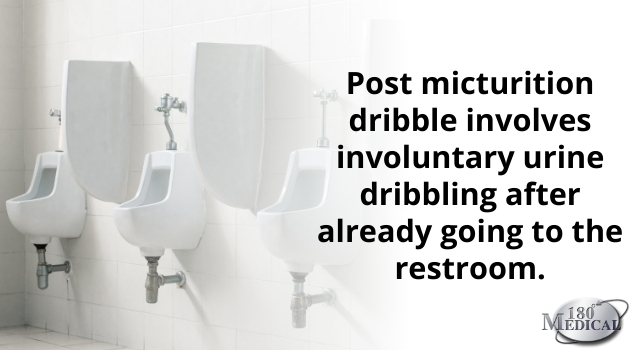
For many men, incontinence and involuntary bladder leakage can be sources of frustration and embarrassment. While the risk of incontinence may increase with age, the various types of incontinence in men may also be caused by bladder or prostate issues, surgeries, injuries, or conditions affecting the nervous system. The good news is that incontinence is both common and treatable in many cases.
One of the best ways to manage male incontinence is to start by learning about the types of incontinence that commonly impact men.
Types of Male Urinary Incontinence
Urge Incontinence
Urge incontinence may be one of the most common types of incontinence that impact men, representing anywhere from 40 to 80% of males. This type of incontinence occurs when the urge to urinate leads to sudden, involuntary urine leakage.
In men, urge incontinence occurs for a variety of reasons, such as damage to the nerves that extend to the bladder. Also, the aftermath of prostate surgery can sometimes cause urge incontinence in men.
Stress Incontinence
Sudden physical exertion can lead to what is known as stress incontinence. Activities such as laughing, sneezing, coughing, physical activity such as heavy lifting, or making a quick change in position may sometimes put a strain or stress on one’s bladder. This leads to urine leakage, which can range from mild to severe.
In men, stress incontinence may occur due to weakened pelvic floor muscles. Other times, it may be due to damage to the urinary bladder’s sphincter, which may occur through injuries such as a pelvic fracture or complications due to prostate surgery. In other words, the bladder may not have enough muscular support to hold urine in without leaking.

Overflow Incontinence
Overflow incontinence in men typically means that an individual still has the urge to urinate but can only release urine in small episodic amounts at a time.
This type of incontinence is usually caused by nerve damage, an enlarged prostate gland, a narrowing urethra, or weakening bladder muscles. Also, it may occur due to urethral obstructions, which can sometimes lead to urine build-up within the bladder and eventual slow leakage.
Post-Micturition Dribble
Post-micturition dribble, which is also known as PMD, is the involuntary loss of urine immediately after passing urine normally. In other words, men experiencing post-micturition dribble may have bladder leakage after already urinating.

Post-micturition dribble may occur due to weakened pelvic floor muscles, which surround the urethra and bladder.
Pelvic floor muscles may naturally weaken with age. However, other reasons for the weakening of the pelvic floor could be due to issues such as:
- Being overweight
- Strain from heavy lifting
- Neurological damage
- Constant coughing
- Prostate operations
- Constipation and straining to empty the bowels
Functional Incontinence
This form of male urinary incontinence occurs when the individual is aware they need to urinate but are physically or mentally unable to reach the bathroom in time. This may occur when an individual has a condition such as dementia or Alzheimer’s disease or impaired mobility or eyesight.
Because of the nature of this type of incontinence, it is most common in the elderly and those with disabilities.
Mixed Incontinence
Also, men can also deal with mixed incontinence, which is a mix of different types of incontinence in men. For example, an individual could have a combination of symptoms related to both stress and urge incontinence. This might lead to a diagnosis of mixed incontinence, which can affect up to 30% of men with urinary incontinence symptoms.
How Is Male Incontinence Treated?
If you have one of the above types of urinary incontinence, the first step is to make an appointment to see your doctor or a urologist. They will be able to perform tests and examinations to determine the root cause of your bladder leakage. Then they can diagnose the issue and come up with a treatment or management plan.
Potential solutions for incontinence may include lifestyle changes such as pelvic floor exercises, bladder retraining, or a weight loss plan. Additionally, you may need medication, electric stimulation therapy, or surgery in cases of severe male incontinence.
Your healthcare professional may also recommend incontinence supplies or intermittent catheters to help fully drain the bladder.
Are Catheters for Male Incontinence Right for Me?
If your doctor has recommended catheterization as a way to treat male incontinence, you have several options. Learn more about the types of catheters for men.
If you’re ready to explore your insurance-covered options, reach out to the experts at 180 Medical.
